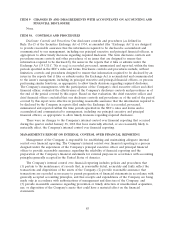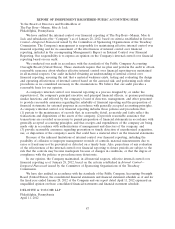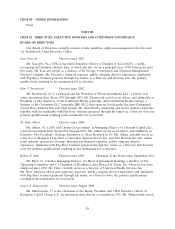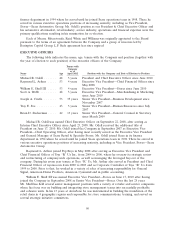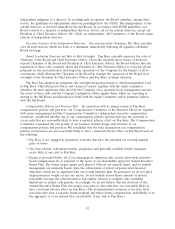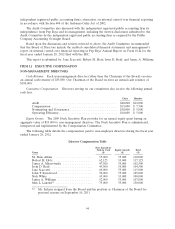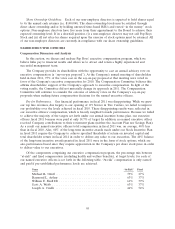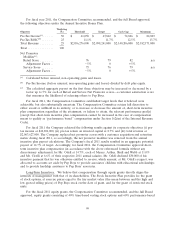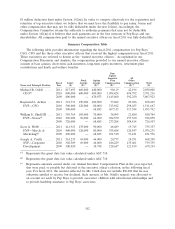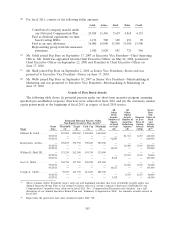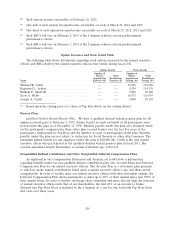Pep Boys 2011 Annual Report Download - page 139
Download and view the complete annual report
Please find page 139 of the 2011 Pep Boys annual report below. You can navigate through the pages in the report by either clicking on the pages listed below, or by using the keyword search tool below to find specific information within the annual report.
Share Ownership Guidelines. Each of our non-employee directors is expected to hold shares equal
to 4x the annual cash retainer (i.e. $140,000). The share ownership levels may be satisfied through
direct share ownership and/or by holding unvested time-based RSUs and vested ‘‘in the money’’ stock
options. Non-employee directors have five years from their appointment to the Board to achieve their
expected ownership level. If in a shortfall position, (i) a non-employee director may not sell Pep Boys
Stock and (ii) all net after-tax shares acquired upon the exercise of stock options must be retained. All
of our non-employee directors are currently in compliance with our share ownership guidelines.
NAMED EXECUTIVE OFFICERS
Compensation Discussion and Analysis
In this section, we discuss and analyze Pep Boys’ executive compensation program, which we
believe links pay to financial results and allows us to attract and retain a highly experienced and
successful management team.
The Company provides its shareholders with the opportunity to cast an annual advisory vote on
executive compensation (a ‘‘say-on-pay proposal’’). At the Company’s annual meeting of shareholders
held in June 2011, 97% of the votes cast on the say-on-pay proposal at that meeting were voted in
favor of the Company’s executive compensation for 2010. The Compensation Committee believes this
affirms shareholders’ support of the Company’s approach to executive compensation. In light of the
voting results, the Committee did not materially change its approach in 2011. The Compensation
Committee will continue to consider the outcome of advisory votes on the Company’s say-on-pay
proposals when making future compensation decisions for the named executive officers.
Pay for Performance. Our financial performance in fiscal 2011 was disappointing. While we grew
our top line revenues, due largely to our opening of 119 Service & Tire Centers, we failed to improve
our profitability over the levels achieved in fiscal 2010. These disappointing results were reflected in
our executive officers’ compensation, which is heavily weighted towards performance. Because we failed
to achieve the majority of the targets set forth under our annual incentive bonus plan, our executive
officers fiscal 2011 bonuses were paid at only 14.7% of target. In addition, no named executive officer
received Company contributions to their retirement plans (neither the Account Plan nor Savings Plan).
As a result our named executive officers total compensation in fiscal 2011 was, on average, 40% less
than in fiscal 2010. Also, 60% of the long-term incentive awards made under our Stock Incentive Plan
in fiscal 2011 require the Company to achieve specified thresholds of return on invested capital and
total shareholder return in fiscal 2014 in order to deliver any value to our executives. The 40% balance
of the long-term incentive awards granted in fiscal 2011 were in the form of stock options, which are
also performance-based since they require appreciation in the Company’s per share stock price in order
to deliver value to our executives.
Of the components comprising our executive compensation program, the percentage mix between
‘‘at-risk’’ and fixed compensation (excluding health and welfare benefits), at target levels, for each of
our named executive officers is set forth in the following table. ‘‘At-risk’’ compensation is only earned
and paid if pre-established performance levels are achieved.
Name ‘‘At-Risk’’ Fixed
Michael R. Odell ..................................... 73% 27%
Raymond L. Arthur ................................... 63% 37%
William E. Shull III ................................... 61% 39%
Scott A. Webb ....................................... 63% 37%
Joseph A. Cirelli ..................................... 46% 54%
95


